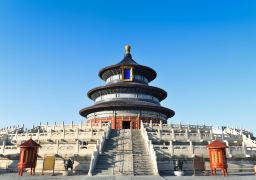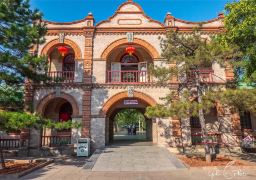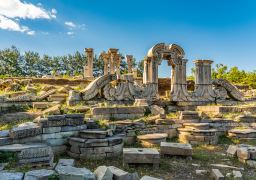The Taihe Palace is the supreme treasure hall in the Forbidden City. It is known as the ‘Golden Throne Hall’ in the imperial palace among the people. The hall is located on a three-tiered white marble platform. Inside and outside, it is decorated with thousands of golden dragon patterns. There are ten ridge beasts installed at the corners of the roof ridges. The hall is paved with golden bricks. On the seven-tier high platform in the hall is placed the extremely exquisite golden lacquer cloud dragon pattern throne of the emperor.
Above the throne hangs an inscribed plaque with the words ‘Establishing the Ultimate and Bringing Peace and Guidance’. The Taihe Palace is an existing ancient building with high specifications and is the only one of its kind. It is the essence of ancient Chinese palace architecture and also the largest wooden structure hall in existence in China. The Taihe Palace was initially built in the Yongle period of the Ming Dynasty and was originally called the Fengtian Hall. In the Jiajing period of the Ming Dynasty, it was renamed the Huangji Hall. After the Manchu people entered Beijing, it was renamed the Taihe Palace, containing the wish for harmony in the world. The present Taihe Palace was rebuilt and preserved in the Kangxi period of the Qing Dynasty. Standing in the center of the Forbidden City, the Taihe Palace is the main hall of the three main halls in the front court and is also the center of gravity of the Forbidden City. Nowadays, many people think that the emperor usually holds court in the Taihe Palace. But in fact, the Taihe Palace is rarely opened. It is only used here when major ceremonies are held, such as the emperor’s enthronement, the emperor’s grand wedding, the appointment of the empress, and the dispatch of generals. In addition, on the three major festivals of the emperor’s birthday, New Year’s Day, and Winter Solstice, the emperor will receive congratulations from civil and military officials in the Taihe Palace and grant banquets to princes and ministers. The places where emperors of the Ming and Qing Dynasties held court are mainly at the Taihe Gate, the Qianqing Gate, the Qianqing Palace, and the Yangxin Palace, not the Taihe Palace. Opening hours: From November 1st to March 31st, open from Tuesday to Sunday from 08:30 to 16:30; from April 1st to October 31st, open from Tuesday to Sunday from 08:30 to 17:00; closed all day on Mondays throughout the year; on New Year’s Day and Spring Festival, open from 08:30 to 16:30; on Tomb-Sweeping Day, Labor Day, Dragon Boat Festival, Mid-Autumn Festival, and National Day, open from 08:30 to 17:00.Taihe Palace
The Taihe Palace is the supreme treasure hall in the Forbidden City. It is known as the ‘Golde[...]









